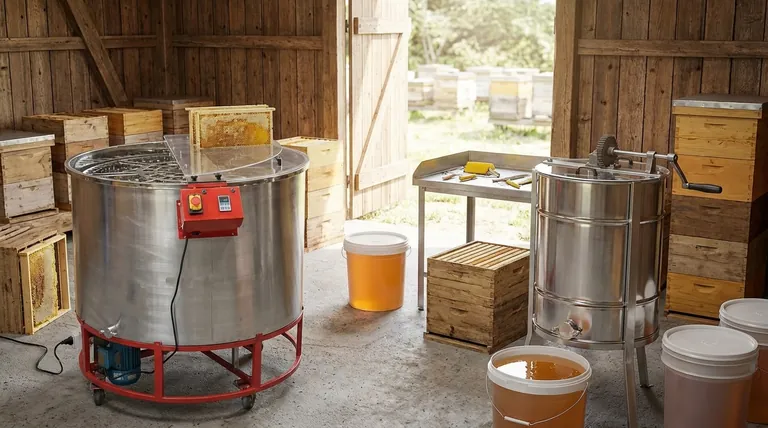The fundamental difference is the power source. An electric honey extractor uses a motor to spin the frames and extract honey via centrifugal force, whereas a manual extractor requires you to turn a hand crank to generate the same spinning motion.
While the power source is the technical distinction, the real difference is one of scale and philosophy. Your choice depends entirely on the number of hives you manage and whether you prioritize cost-efficiency for a small hobby or time-savings for a larger operation.

The Core Difference: Power and Control
The mechanism for extracting honey is identical in both types—spinning frames to sling honey out. The key distinction lies in how that spinning force is generated and what that means for your workflow.
The Electric Extractor: Automated Power
An electric extractor is built for efficiency and consistency. The motor spins the frames at a high, steady speed, requiring minimal physical input from the beekeeper.
This automation significantly reduces the time and labor involved in the extraction process, especially when processing honey from multiple hives.
The Manual Extractor: Hands-on Control
A manual extractor operates on your physical effort. You turn a hand crank, which rotates a set of gears to spin the basket holding the frames.
This provides direct, tactile control over the extraction speed. However, it is a much more labor-intensive and slower process compared to its electric counterpart.
How Scale Dictates Your Choice
The most critical factor in your decision is the size of your beekeeping operation. The right tool for a backyard hobbyist is fundamentally different from the right tool for a semi-commercial beekeeper.
For the Small-Scale Hobbyist (1-10 Hives)
A manual extractor is the logical and cost-effective choice for beekeepers with just a few hives.
The volume of honey is manageable, and the physical effort required for a small batch is not overwhelming. The lower initial cost makes it an accessible entry point.
For the Serious Beekeeper (10+ Hives)
An electric extractor becomes a practical necessity as your apiary grows. The time and labor saved during harvest are immense.
For medium to large-scale operations, the efficiency gains of an electric model far outweigh its higher initial cost, transforming a multi-day chore into a manageable task.
Understanding the Trade-offs
Choosing an extractor involves balancing cost, time, and personal preference. Neither option is universally "better"; they simply serve different needs.
Investment Cost
A manual extractor is significantly less expensive. This makes it the clear winner for those on a tight budget or just starting out.
An electric extractor represents a larger upfront investment. This cost is justified by the efficiency it provides to larger-scale beekeepers.
Time and Labor
Electric models are the undisputed champions of speed and ease. They allow you to "set it and forget it," freeing you to perform other tasks like uncapping the next set of frames.
Manual extraction is physically demanding and slow. The process of cranking, stopping, flipping frames, and cranking again takes considerable time and energy.
The "Tactile" Experience
Some hobbyists prefer the hands-on nature of a manual extractor. It offers a quieter, more connected feeling to the harvest process, aligning with the core ethos of small-scale beekeeping.
Making the Right Choice for Your Apiary
Ultimately, the decision comes down to a realistic assessment of your beekeeping goals and the scale of your operation.
- If your primary focus is a small hobby apiary (fewer than 10 hives): A manual extractor offers the best balance of cost and functionality for your needs.
- If your primary focus is efficiency and a growing operation (more than 10 hives): An electric extractor is a worthwhile investment that will save you significant time and labor.
- If your primary focus is the hands-on experience of beekeeping: A manual extractor provides a more direct, tactile connection to the harvesting process, regardless of hive count.
Choosing the right extractor is about aligning your equipment with the scale and philosophy of your beekeeping journey.
Summary Table:
| Feature | Electric Extractor | Manual Extractor |
|---|---|---|
| Power Source | Electric Motor | Hand Crank |
| Best For | 10+ Hives (Larger Operations) | 1-10 Hives (Small Hobbyists) |
| Key Advantage | Speed & Labor Savings | Lower Cost & Tactile Control |
| Primary Consideration | Higher Initial Investment | Physical Effort & Time Required |
Ready to Optimize Your Honey Harvest?
Whether you're a commercial apiary scaling up or a distributor stocking the right equipment, choosing the correct extractor is crucial for efficiency and profitability. HONESTBEE supplies durable, high-performance beekeeping equipment, including a range of honey extractors designed for operations of all sizes.
We help you:
- Save Time & Labor with efficient electric models for larger harvests.
- Maximize Your Budget with cost-effective manual options for smaller operations.
- Ensure Reliability with commercial-grade equipment built to last.
Let's discuss the best extractor for your specific needs. Contact our experts today!
Visual Guide

Related Products
- HONESTBEE 72 Frame Industrial Electric Honey Extractor for Beekeeping
- Electric 8 Frame Honey Spinner Extractor Equipment for Beekeeping
- HONESTBEE 3-Frame Manual Acrylic Honey Extractor
- Commercial Electric 12 Frame Honey Extractor Spinner Motorized Honey Extractor
- electric honey extractor honey centrifuge 3 frame honey extractor stainless steel honey frame extractor
People Also Ask
- What are the advantages of automatic honey extractors? Scale Your Apiary with Unmatched Efficiency
- How do automatic honey extractors function? Achieve High-Efficiency Honey Harvesting
- What are the two common types of honey extractors? Choose the Right Extractor for Your Apiary
- What are the advantages of automated honey extractors in terms of time efficiency? Boost Your Harvest Speed
- Why is preserving honeycomb integrity important, and how do automated extractors help? Boost Hive Health & Honey Yields



















